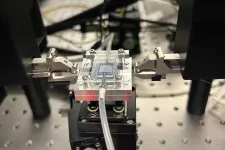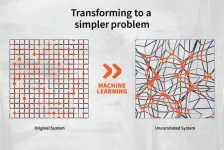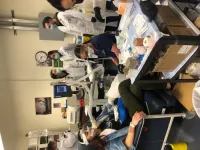(Press-News.org) · The need for low cost but effective obesity treatments has become urgent
· ‘At this stage, treatment still needs a human because the tech alone doesn’t produce clinically acceptable weight loss for most people’
· Not previously known whether tech alone could produce clinically acceptable weight loss
CHICAGO --- A new Northwestern Medicine study shows that technology alone can’t replace the human touch to produce meaningful weight loss in obesity treatment.
“Giving people technology alone for the initial phase of obesity treatment produces unacceptably worse weight loss than giving them treatment that combines technology with a human coach,” said corresponding study author Bonnie Spring, director of the Center for Behavior and Health and professor of preventive medicine at Northwestern University Feinberg School of Medicine.
The need for low cost but effective obesity treatments delivered by technology has become urgent as the ongoing obesity epidemic exacerbates burgeoning health care costs.
But current technology is not advanced enough to replace human coaches, Spring said.
In the new SMART study, people who initially only received technology without coach support were less likely to have a meaningful weight loss, considered to be at least 5% of body weight, compared to those who had a human coach at the start.
Investigators intensified treatment quickly (by adding resources after just two weeks) if a person showed less than optimal weight loss, but the weight loss disadvantage for those who began their weight loss effort without coach support persisted for six months, the study showed.
The study will be published May 14 in JAMA.
Eventually more advanced technology may be able to supplant human coaches, Spring said.
“At this stage, the average person still needs a human coach to achieve clinically meaningful weight loss goals because the tech isn’t sufficiently developed yet,” Spring said. “We may not be so far away from having an AI chat bot that can sub for a human, but we are not quite there yet. It’s within reach. The tech is developing really fast.”
Previous research showed that mobile health tools for tracking diet, exercise and weight increase engagement in behavioral obesity treatment. Before this new study, it wasn’t clear whether they produced clinically acceptable weight loss in the absence of support from a human coach.
Scientists are now trying to parse what human coaches do that makes them successful, and how AI can better imitate a human, not just in terms of content but in emotional tone and context awareness, Spring said.
Surprising results
“We predicted that starting treatment with technology alone would save money and reduce burden without undermining clinically beneficial weight loss, because treatment augmentation occurred so quickly once poor weight loss was detected,” Spring said. “That hypothesis was disproven, however.”
Drug and surgical interventions also are available for obesity but have some drawbacks. “They’re very expensive, convey medical risks and side effects and aren’t equitably accessible,” Spring said. Most people who begin taking a GLP-1 agonist stop taking the drug within a year against medical advice, she noted.
Many people can achieve clinically meaningful weight loss without antiobesity medications, bariatric surgery or even behavioral treatment, Spring said. In the SMART study, 25% of people who began treatment with technology alone achieved 5% weight loss after six months without any treatment augmentation. (In fact, the team had to take back the study technologies after three months to recycle to new participants.)
An unsolved problem in obesity treatment is matching treatment type and intensity to individuals’ needs and preferences. “If we could just tell ahead of time who needs which treatment at what intensity, we might start to manage the obesity epidemic,” Spring said.
How the study worked
The SMART Weight Loss Management study was a randomized controlled trial that compared two different stepped care treatment approaches for adult obesity. Stepped care offers a way to spread treatment resources across more of the population in need. The treatment that uses the least resources but that will benefit some people is delivered first; then treatment is intensified only for those who show insufficient response. Half of participants in the SMART study began their weight loss treatment with technology alone. The other half began with gold standard treatment involving both technology and a human coach.
The technology used in the SMART trial was a Wireless Feedback System (an integrated app, Wi-Fi scale and Fitbit) that participants used to track and receive feedback about their diet, activity and weight.
Four-hundred adults between ages 18-60 with obesity were randomly assigned to begin three months of stepped care behavioral obesity treatment beginning with either the Wireless Feedback System (WFS) alone or the WFS plus telehealth coaching. Weight loss was measured after two, four and eight weeks of treatment, and treatment was intensified at the first sign of suboptimal weight loss (less than .5 pounds per week).
Treatment for both groups began with the same WFS tracking technology, but standard-of-care treatment also transmitted the participant’s digital data to a coach, who used it to provide behavioral coaching by telehealth. Those showing suboptimal weight loss in either group were re-randomized once to either of two levels of treatment intensification: modest (adding an inexpensive technology component — supportive messaging) or vigorous (adding both messaging plus a more costly traditional weight loss treatment component – coaching for those who hadn’t received it, meal replacement for those who’d already received coaching).
The article is titled “An Adaptive Behavioral Intervention for Weight Loss Management:
A Noninferiority Randomized Clinical Trial.”
Other Northwestern authors are Dr. Juned Siddique, Jean Reading, Samuel Battalio, Elyse Daly, Laura Scanlan and H. Gene McFadden.
The study was supported by National Institute of Diabetes and Digestive and Kidney Diseases grant R01DK108678, National Institute of Heart, Lung, and Blood grant F31HL162555, National Cancer Institute grant T32CA193193, all of the National Institutes of Health.
END
Tech can’t replace human coaches in obesity treatment
Technology alone resulted in worse weight loss compared to tech and a telehealth coach
2024-05-15
ELSE PRESS RELEASES FROM THIS DATE:
Severe obesity in childhood can halve life expectancy, global modelling study finds
2024-05-15
Impact of age of onset, severity and duration of childhood obesity quantified for the first time
Early onset obesity model finds that a child who is living with severe obesity at age 4 and doesn’t lose weight has a life expectancy of just 39. But weight loss can give back decades of life
Childhood obesity is a life-threatening disease, say researchers
New research being presented at the European Congress on Obesity (ECO) in Venice, Italy (12-15 May) has, for the first time, quantified the impact of different aspects of childhood obesity on long-term health and life expectancy.
The modelling by stradoo GmbH, a life sciences consultancy ...
Study supports lower BMI threshold for obesity in the over 40s
2024-05-15
Changes in body composition with ageing—increases in body fat and declines in muscle—mean that BMI is not accurate in predicting obesity in middle-aged and older adults.
BMI identified half as many over 40s with obesity as predicted by body fat percentage.
A new lower BMI cut-off for obesity based on body fat percentage (27kg/m²) in the over 40s may be more appropriate than the existing WHO BMI threshold (30 kg/m²).
The authors say establishing this new lower BMI cut-off point for the over 40s in clinical settings and obesity guidelines potentially ...
Text messages with financial incentives can help men who are living with obesity lose weight, UK study finds (JAMA)
2024-05-15
Men in England, Scotland and Northern Ireland offered up to £400 for hitting weight loss targets lost more weight than those not given cash incentive
Win-win strategy could pay for itself, say researchers
*Note: this paper is being presented at the European Congress on Obesity (ECO) and is being published in JAMA. Please credit both the congress and the journal in your stories.*
A new study presented at the European Congress on Obesity (ECO) in Venice, Italy (12-15 May), and published simultaneously in JAMA, has concluded that text messages with financial incentives can help men who are living with obesity lose weight and could be a valuable alternative ...
Scientists develop an affordable sensor for lead contamination
2024-05-14
Engineers at MIT, Nanytang Technological University, and several companies have developed a compact and inexpensive technology for detecting and measuring lead concentrations in water, potentially enabling a significant advance in tackling this persistent global health issue.
The World Health Organization estimates that 240 million people worldwide are exposed to drinking water that contains unsafe amounts of toxic lead, which can affect brain development in children, cause birth defects, and produce a variety of neurological, cardiac, ...
UC Irvine-led study links sleep apnea severity during REM stage to verbal memory decline
2024-05-14
Irvine, Calif., May 14, 2024 — A research team led by the University of California, Irvine has revealed the link between the frequency of sleep apnea events during the rapid-eye-movement stage and the severity of verbal memory impairment in older adults at risk for Alzheimer’s disease. Verbal memory refers to the cognitive ability to retain and recall information presented through spoken words or written text and is particularly vulnerable to Alzheimer’s.
The study, recently published online in the journal Alzheimer’s Research & Therapy, discovered a specific correlation between the severity of sleep apnea – when breathing pauses while ...
What’s actually in your supplements? Chapman University researchers detect hidden ingredients and questionable claims in supplements
2024-05-14
A recent study published in Analytical Science Journal conducted by Schmid College of Science and Technology Professor Rosalee Hellberg and students Calin Harris, Diane Kim, Miranda Miranda and Chevon Jordan, reveal that some supplement companies may mislead customers with unproven health claims and undeclared ingredients.
The researchers focused on supplements that have been associated with the purported treatment or prevention of COVID-19 and other respiratory illnesses. During the pandemic, the use of dietary supplements skyrocketed throughout the world. “There was a big spike in purchase and use of these types ...
STRIVE project to study ozone, atmospheric layers among finalists for next-generation NASA satellite
2024-05-14
A project led by the University of Washington to better understand our atmosphere’s complexity is a finalist for NASA’s next generation of Earth-observing satellites. The space agency this week announced the projects that will each receive $5 million to advance to the next stage and conduct a one-year concept study.
STRIVE seeks to better understand the troposphere that we inhabit and the stratosphere above it, where the ozone layer is, as well as the interface where these two layers meet. That interface, about 6 miles (10 kilometers) above the surface, is where important ...
Simulating diffusion using 'kinosons' and machine learning
2024-05-14
Researchers from the University of Illinois Urbana-Champaign have recast diffusion in multicomponent alloys as a sum of individual contributions, called “kinosons.” Using machine learning to compute the statistical distribution of the individual contributions, they were able to model the alloy and calculate its diffusivity orders of magnitude more efficiently than computing whole trajectories. This work was recently published in the journal Physical Review Letters.
“We found a much more efficient way to calculate diffusion in solids, and at the same time, we learned more ...
Far from toxic, lactate rivals glucose as body's major fuel after a carbohydrate meal
2024-05-14
As a student competing in track and field at his Parlier high school, Robert Leija was obsessed with how to improve his performance and, in particular, prevent the buildup of lactic acid in his muscles during training. Like many athletes, he blamed it for the performance fatigue and muscle soreness he experienced after intense workouts.
But as a kinesiology student at Fresno State, he was handed an out-of-print textbook that told him he had it all wrong. Lactate wasn't a danger sign that athletes had depleted their body's supply of oxygen, but likely a normal product of the metabolic activity required to fuel the muscles during sustained exercise.
Now, as a graduate student ...
AI for more caring institutions
2024-05-14
More and more public services — such as affordable housing, public school matching and child welfare — are relying on algorithms to make decisions and allocate resources. So far, much of the work that has gone into designing these systems has focused on workers’ experiences using them or communities’ perceptions of them.
But what about the actual impact of these programs have on people, especially when the decisions the systems make lead to denial of services? Can you design algorithms to help people make sense of and ...
LAST 30 PRESS RELEASES:
UCLA study links scar healing to dangerous placenta condition
CHANGE-seq-BE finds off-target changes in the genome from base editors
The Journal of Nuclear Medicine Ahead-of-Print Tip Sheet: January 2, 2026
Delayed or absent first dose of measles, mumps, and rubella vaccination
Trends in US preterm birth rates by household income and race and ethnicity
Study identifies potential biomarker linked to progression and brain inflammation in multiple sclerosis
Many mothers in Norway do not show up for postnatal check-ups
Researchers want to find out why quick clay is so unstable
Superradiant spins show teamwork at the quantum scale
Cleveland Clinic Research links tumor bacteria to immunotherapy resistance in head and neck cancer
First Editorial of 2026: Resisting AI slop
Joint ground- and space-based observations reveal Saturn-mass rogue planet
Inheritable genetic variant offers protection against blood cancer risk and progression
Pigs settled Pacific islands alongside early human voyagers
A Coral reef’s daily pulse reshapes microbes in surrounding waters
EAST Tokamak experiments exceed plasma density limit, offering new approach to fusion ignition
Groundbreaking discovery reveals Africa’s oldest cremation pyre and complex ritual practices
First breathing ‘lung-on-chip’ developed using genetically identical cells
How people moved pigs across the Pacific
Interaction of climate change and human activity and its impact on plant diversity in Qinghai-Tibet plateau
From addressing uncertainty to national strategy: an interpretation of Professor Lim Siong Guan’s views
Clinical trials on AI language model use in digestive healthcare
Scientists improve robotic visual–inertial trajectory localization accuracy using cross-modal interaction and selection techniques
Correlation between cancer cachexia and immune-related adverse events in HCC
Human adipose tissue: a new source for functional organoids
Metro lines double as freight highways during off-peak hours, Beijing study shows
Biomedical functions and applications of nanomaterials in tumor diagnosis and treatment: perspectives from ophthalmic oncology
3D imaging unveils how passivation improves perovskite solar cell performance
Enriching framework Al sites in 8-membered rings of Cu-SSZ-39 zeolite to enhance low-temperature ammonia selective catalytic reduction performance
AI-powered RNA drug development: a new frontier in therapeutics
[Press-News.org] Tech can’t replace human coaches in obesity treatmentTechnology alone resulted in worse weight loss compared to tech and a telehealth coach



